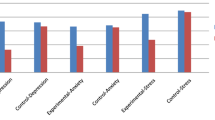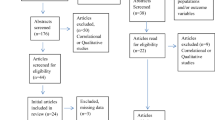Abstract
The increasing number of mental health disorders on university students represents a growing problem with negative impact on this population. Stress and anxiety issues are two of most predominant problems in this population and most campus health services have limited resources to face them. Research has provided evidence about biofeedback effectiveness. This study aims to verify the impact of a short duration biofeedback programme on freshmen university students with high levels of anxiety. A sample of 50 first-year students, with scores above percentile of 75 on STAI Y-2 were randomly selected and divided into two groups. Biofeedback Group took a 15 min session per week, over 8 weeks. No intervention was made on Control Group. Both groups were assessed before and after the biofeedback programme, and the results of the Trait Anxiety Scale and the Inventory of Stress for College Students were compared. The Biofeedback Group presented significant decreases in anxiety and stress values. Control Group presented slight and non-significant changes in scores. These results are consistent with previous studies and reinforce the evidence of biofeedback’s programmes as a valid solution to help students to manage their anxiety and stress.



Similar content being viewed by others
References
Bayram, N., & Bilgel, N. (2008). The prevalence and socio-demographic correlations of depression, anxiety and stress among a group of university students. Social Psychiatry and Psychiatric Epidemiology, 43(8), 667–672.
Dyson, R., & Renk, K. (2006). Freshmen adaptation to university life: Depressive symptoms, stress, and coping. Journal of Clinical Psychology, 62(10), 1231–1244.
Henriques, G., Keffer, S., Abrahamson, C., & Horst, S. J. (2011). Exploring the effectiveness of a computer-based heart rate variability biofeedback program in reducing anxiety in college students. Applied Psychophysiology and Biofeedback, 36(2), 101–112. doi:10.1007/s10484-011-9151-4.
Jarasiunaite, G., Perminas, A., Gustainiene, L., Peciuliene, I., & Kavaliauskaite-Keserauskiene, R. (2015). Biofeedback-assisted relaxation and progressive muscle relaxation potential for enhancing students’ distress tolerance. European Scientific Journal, 11(2), 1857–7881.
Kassim, M., Hanafi, S., & Hancock, D. (2009). Test anxiety and its consequences on academic performance among university students. In B. Ayres & M. Bristow (Eds.), Anxiety in college students (pp. 67–88). New York: Nova Science Publishers.
Lantyer, A., Viana, M., & Padovani, R. (2013). Biofeedback no tratamento de transtornos relacionados ao estresse e à ansiedade: Uma revisão crítica (Biofeedback in the treatment of disorders related to stress and anxiety: A critical review). Psico-USF, 18(1), 131–140.
Lee, J., Kim, J., & Wachholtz, A. (2015). The benefit of heart rate variability biofeedback and relaxation training in reducing trait anxiety. The Korean Journal of Health Psychology, 20(2), 391–408.
Lindsey, C. (2014). Trait anxiety in college students: The role of the approval seeking schema and separation individuation. College Student Journal, 48(3), 407–418.
McKee, M. (2008). Biofeedback: An overview in the context of heart-brain medicine. Cleveland Clinic Journal of Medicine, 75(Suppl. 2), 31–34. doi:10.3949/ccjm.75.Suppl_2.S31.
Meier, N., & Welch, A. (2015). Walking versus biofeedback: A comparison of acute interventions for stressed students. Anxiety, Stress, and Coping, 29(5), 463–478. doi:10.1080/10615806.2015.1085514.
Napper, L., LaBrie, J., & Hummer, J. (2015). Anxiety and the use of alcohol-related protective behavioral strategies. Journal of College Counseling, 18(1), 21–36. doi:10.1002/j.2161-1882.2015.00066.x.
Pereira, A., Vaz, A., Medeiros, J., Lopes, P., Melo, A., Ataíde, R., & Ferreira, J. (2004). Características psicométricas do inventário do stresse em estudantes universitários – Estudo exploratório (Psychometric characteristics of the stress inventory in university students - A pilot study). In C. Machado, L. Almeida, M. Gonçalves, & V. Ramalho (Eds.), Actas da X conferência internacional de avaliação psicológica: Formas e contextos (pp. 326–329). Braga: Psiquilíbrios Edições.
Ratanasiripong, P., Kaewboonchoo, O., Ratanasiripong, N., Hanklang, S., & Chumchai, P. (2015a). Biofeedback intervention for stress, anxiety, and depression among graduate students in public health nursing. Nursing Research and Practice, 2015, 1–5. doi:10.1155/2015/160746.
Ratanasiripong, P., Park, J., Ratanasiripong, N., & Kathalae, D. (2015b). Stress and anxiety management in nursing students: Biofeedback and mindfulness meditation. Journal of Nursing Education, 54(9), 520–524. doi:10.3928/01484834-20150814-07.
Ratanasiripong, P., Ratanasiripong, N., & Kathalae, D. (2012a). Biofeedback intervention for stress and anxiety among nursing students: A randomized controlled trial. ISRN Nursing, 2012, 1–5. doi:10.5402/2012/827972.
Ratanasiripong, P., Sverduk, K., Prince, J., & Hayashino, D. (2012b). Biofeedback and counseling for stress and anxiety among college students. Journal of College Student Development, 53(5), 742–749. doi:10.1353/csd.2012.0070.
Sadigh, R., Himmanen, S., & Scepansky, J. (2014). An investigation of the prevalence of insomnia in college students and its relationship to trait anxiety. College Student Journal, 48(3), 397–406.
Schuhfried. (2008). Biofeedback 2000 x-pert Hardware’s Manual (V 3.0). Viena: Schuhfried.
Silva, D., & Spielberger, C. (2007). Manual do inventário de estado-traço de ansiedade (Manual for the statetrait anxiety inventory). Menlo Park: Mind Garden, Inc.
Yucha, C., & Montgomery, D. (2008). Evidence-based practice in biofeedback and neurofeedback. Wheat Ridge, CO: Association for Applied Psychophysiology and Biofeedback.
Author information
Authors and Affiliations
Corresponding author
Ethics declarations
Conflict of interest
The authors declare that they have no conflict of interest.
Ethical Approval
All procedures performed in studies involving human participants were in accordance with the ethical standards of the institutional and/or national research committee and with the 1964 Helsinki declaration and its later amendments or comparable ethical standards.
Informed Consent
Informed consent was obtained from all individual participants included in the study.
Rights and permissions
About this article
Cite this article
Chaló, P., Pereira, A., Batista, P. et al. Brief Biofeedback Intervention on Anxious Freshman University Students. Appl Psychophysiol Biofeedback 42, 163–168 (2017). https://doi.org/10.1007/s10484-017-9361-5
Published:
Issue Date:
DOI: https://doi.org/10.1007/s10484-017-9361-5




